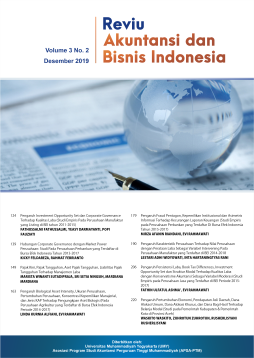Penentuan Jumlah Sampel pada Penelitian Akuntansi dan Bisnis Berpendekatan Kuantitatif
DOI:
https://doi.org/10.18196/rabin.v7i2.19031Keywords:
Sampel Minimal, Penelitian Akuntansi dan Bisnis, Skripsi, TesisAbstract
Latar Belakang: Isu penentuan jumlah sampel sering kali menjadi hal yang terabaikan di beberapa penelitian skripsi dan tesis.
Tujuan: Paper ini mendiskusikan beberapa metode penentuan sampel yang dapat diadopsi oleh mahasiswa Sarjana dan Magister yang tengah menyelesaikan tugas akhir skripsi dan tesis mereka.
Metode: Paper ini merangkum beberapa pendapat ahli terkait penentuan jumlah sampel minimal pada studi akuntansi dan bisnis yang umum digunakan.
Hasil: Terdapat tiga metode yang belakangan sering digunakan dalam menentukan jumlah sampel minimal dengan argumentasi dan relevansi masing-masing, yakni: Pendekatan 10 kali rule of thumbs indikator variabel Laten untuk studi menggunakan Partial Least Square (PLS), Analisis Power, dan Tabel Krejcie dan Morgan.
Keaslian/Kebaruan: Paper ini memberikan penyegaran kepada isu krusial pada riset kuantitatif yang kerap terabaikan, yakni penentuan jumlah sampel minimal.
References
Hair, J. F., Hult, G. T. M., Ringle, C. M., & Sarstedt, M. (2021). A primer on partial least squares structural equation modeling (PLS-SEM): Sage publications. https://doi.org/10.1007/978-3-030-80519-7
Krejcie, R. V., & Morgan, D. W. (1970). Determining sample size for research activities. Educational and psychological measurement, 30(3), 607-610. https://doi.org/10.1177/001316447003000308
Memon, M., Ting, H., Cheah, J., Ramayah, T., Chuah, F., & Cham, T. (2020). Sample size for survey research: review and recommendations. Journal of Applied Structural Equation Modelling, 4(2), 1-20. https://doi.org/10.47263/JASEM.4(2)01
Pratolo, S., Sofyani, H., & Anwar, M. (2020). Performance-based budgeting implementation in higher education institutions: Determinants and impact on quality. Cogent Business & Management, 7(1), 1786315. https://doi.org/10.1080/23311975.2020.1786315
Qureshi, I., & Compeau, D. (2009). Assessing between-group differences in information systems research: A comparison of covariance-and component-based SEM. MIS quarterly, 197-214. https://doi.org/10.2307/20650285
Sekaran, U., & Bougie, R. (2019). Research methods for business: A skill building approach: John Wiley & Sons.
Sofyani, H., Hasan, H. A., & Saleh, Z. (2022). The Moderating Role of IT Development on the Relationship between Internal Control and the Quality Performance of Higher Education Institutions. Quality Innovation Prosperity, 26(2), 128-146. https://doi.org/10.12776/qip.v26i2.1711
Sofyani, H., Tahar, A., & Ulum, I. (2022). The Role of IT Capabilities and IT Governance on Accountability and Performance of Higher Education Institutions During the COVID-19 Pandemic. Management and Accounting Review, 21(2), 167-190.
Tahar, A., Sofyani, H., Arisanti, E. N., & Amalia, F. A. (2022). Maintaining higher education institution performance amid the COVID-19 pandemic: The role of IT governance, IT capability and process agility. MOJEM: Malaysian Online Journal of Educational Management, 10(1), 45-61.
Zikmund, W. G., Babin, B. J., Carr, J. C., & Griffin, M. (2013). Business research methods: Cengage learning.
Downloads
Published
How to Cite
Issue
Section
License
Artikel ini dilisensikan di bawah Creative Commons Attribution 4.0 International (CC BY 4.0), yang mengizinkan penggunaan, distribusi, dan reproduksi dalam media apa pun, selama atribusi yang sesuai diberikan kepada penulis asli dan sumbernya.










